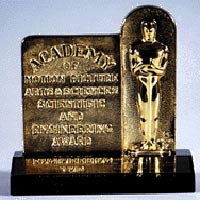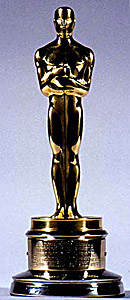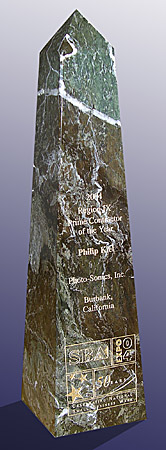|
1924 |
Adolf Furer purchases
Acme Tool and Manufacturing,
a small tool and die shop on San Fernando Road in Los
Angeles. |
|
1928 |
Walt and Roy Disney
contract with the company to modify a Bell &
Howell motion picture camera to provide stop motion
capability for the production of animation.
|
|
1930 |
Disney requests
the company modify additional cameras for production of
animation. Company elects to manufacture a proprietary
camera rather than modify existing cameras. The first
Acme Camera
is designed and manufactured.
|
|
1930 |
Company begins production of complete
line of animation equipment including
Acme Animation Stands,
Acme Animation Boards,
and
Acme Cell Punches. Click
here to see the most prestigious user of Acme equipment. |
|
1936 |
Company
collaborates with Disney to produce the Multiplane
Animation Stand used for the production of
Snow White. |
|
1939 |
Adolf Furer
sells company to his son Edward Furer |
|
1940 |
Company moves to
Olive Avenue in Burbank in response to Disney’s relocation
to the same town.
|
|
1940 |
In collaboration
with special effects pioneer,
Linwood Dunn,
company designs Acme Optical Printer for the production of
motion picture special effects.
Photo-Sonics, Inc. receives
Oscar
in 1980.
|
|
1941
|
Just prior to
the start of the war, the company had commercial orders for
several optical printers and animation stands. At the
outbreak of war, production of commercial products were
suspended. All the products built for existing contracts
were redirected to the war effort. Even the animation stands
were shipped to the Signal Corps in Dayton, Ohio for the
production of animated training films. The company survived
the war by manufacturing airplane parts for a number of the
aviation companies, including Lockheed located in
Burbank.
|
|
1946 |
Company designs
and produces
Kinescope Recording Camera
for recording live television broadcasts. The majority of
the systems were sold to the three major networks.
|
|
1952 |
Photo-Sonics
formed to design and manufacture photo-optical
instrumentation.
|
|
1954 |
Company wins
major contracts from IBM and Goodyear for special film
movements used in the bomb guidance and navigation system of
the B-52 bomber.
|
|
1954 |
Company designs
70mm-10A high-speed pin-registered camera (80 pictures per
second).
|
|
1956 |
Company designed
and manufactured custom
film printers
for Universal,
20th Century-Fox,
Cinerama, Todd-AO, Consolidated Film Industries, Pathe,
Eastman Kodak, Rank Studios, Disney, Warner Brothers,
Columbia Pictures, Hanna Barbera and many others.
|
|
1957 |
Company designs
16mm-1B high-speed rotary prism camera
for use at Hurricane Mesa Test Track in Utah (1000 pictures
per second). |
|
1958 |
Company designs
35mm-4B high speed rotary prism camera
for atomic tests in the South Pacific. This camera remains
today the world’s fastest 35mm rotary prism camera (3200
pictures per second).
|
|
1959 |
Company moves to
new 40,000 square foot facility on Mariposa Street in
Burbank.
|
|
1960 |
Photo-Sonics
wins Navy contract to provide technical support for San
Clemente Island operations. Forty company employees support
photographic, radar, communication and underwater
activities.
|
|
1960 |
Company develops
16mm-1F high-speed rotary prism camera to evaluate the
separation of rocket stages (1000 pictures per second).
|
|
1961 |
Company designs
70mm-10B high-speed rotary prism
camera
for atomic tests in the South Pacific. This camera remains
today the world’s fastest 70mm rotary prism camera (360
pictures per second).
|
|
1962 |
Company designs
the
70mm-CFA streak camera
for evaluating test items on
high speed sleds
(150 feet per second). Camera sees extensive use at Holloman
AFB and China Lake NWC.
|
|
1965 |
Company delivers
the first Cine-Sextant Optical Tracking Mount to the U.S.
Navy at Point Mugu. The Cine-Sextant was designed to replace
modified gun turrets
that were being used at that time to acquire optical data.
|
|
1966 |
Company develops
16mm-1E miniature high-speed rotary prism camera to evaluate
rocket stage separation (600 pictures per second).
|
|
1966 |
Company
employees working under contract for the Navy and using US
Navy CCURV (Cable Controlled Underwater Recovery Vehicle)
recovered a hydrogen bomb "lost" off Palomares, Spain.
For further information, please click on the following link:
http://en.wikipedia.org/wiki/Palomares_hydrogen_bombs_incident |
|
1967 |
Company develops
its first Mil-Std camera, the KB-19A, used extensively in
Vietnam to document the effectiveness of ordnance dropped
from fighter aircraft.
|
|
1967 |
Company develops
the 35mm-4E high-speed camera. It utilizes 4 register pins
and 12 pull down pins and operates reliably at
360 pictures per second.
It remains today the world’s fastest 35mm pin registered
camera.
|
|
1968 |
The 35mm-4E is
used by 20th Century Fox for special effects of
Tora, Tora, Tora. Company begins high-speed camera rental
business. Eventually, hundreds of
commercials and movies
are shot with Photo-Sonics cameras.
|
|
1968 |
The company
rolls out the KB-21C, another documentary ordnance camera. A
commercial version of this camera is designated the
16mm-1P.
Because of its reliability and unique magazine-load
configuration, the 1P and 1PL camera become the most
successful high-speed camera in history with over 2000 units
sold (500
pictures per second).
|
|
1969 |
Company designs
the worlds first magazine load 35mm high-speed camera. The
4ML is used extensively for flight test and launch area
coverage. Several systems have been used on space shuttle to
record experiments (200 pictures per second).
|
|
1970 |
Company wins
competitive “shoot-out” at Nellis AFB and a contract for its
KB-25A Gunsight cameras
used on F-4 aircraft. Company eventually designs and
produces 5000 Gunsight and HUD cameras for every fighter
aircraft in the U.S. inventory with the exception of the
F-15. |
|
1970 |
Company designs
16mm-1PDL ActionMaster-500 camera documentary camera (500
pictures per second).
|
|
1971 |
Company designs
and delivers
Mirror Mount Tracking Systems
for the test and evaluation of the
Sprint Missile System
(2200 degrees per second per second acceleration)
|
|
1971 |
Company forms
Instrumentation Marketing Corporation (IMC) located in
Burbank to distribute products manufactured by Photo-Sonics
and others.
|
|
1971 |
Company forms
International Instrumentation Marketing Corporation (IIMC)
located in Thames, UK to distribute and service Photo-Sonics
products in Europe (later renamed Photo-Sonics International Limited). |
|
1972 |
Company produces
the 70mm-10R high-speed camera. The camera utilizes 4
register-pins and 12 pull-down pins. It remains today the
world’s fastest 70mm pin registered camera (125 pictures per
second). |
|
1972 |
Company
introduces
16mm-1VN, the world’s smallest 16mm high-speed
camera.
|
|
1972 |
Company designs
and delivers the 16mm-1W, the fastest pin-registered film
camera that ever was or ever will be (1000 pictures per
second!).
|
|
1974 |
Company receives
contract to develop Airborne Ground Equipment for the KB-25
and KB-26 series of Gunsight cameras.
|
|
1978 |
Company designs
and deliveries the first of six
Super Radot
tracking mounts to the U.S.
Army in the Kwajalein Atoll in the South Pacific. The Super
Radot tracking mounts are used to track and evaluate the accuracy of
Intercontinental Ballistic Missiles,
re-entry vehicles,
as well as other technologies.
With the 240/480-inch focal length primary lens, the Super
Radot is able to begin tracking targets as far away as 1600
miles down range.
|
|
1978 |
Company awarded
contract by the Israeli government to design and produce the
Model 80 automatic film reader.
|
|
1978 |
Company begins
distribution of NAC SVCR Airborne Video Recorders. 1700
systems are eventually sold.
|
|
1979 |
Company designs
70mm 14S hand-held camera with reflex viewing.
The camera is capable of shooting up to
20
pictures per second. |
| 1979 |
On August 14, 1979, a modified P-51D WWII Mustang fighter took to the sky and achieved a world air speed record of 499.018MPH. Photo-Sonics provided the cameras that were used for the four passes needed to calculate the averaged air speed for the record. The record held for 10 years. Read the story in Wikipedia here. Watch the video covering the day's events. |
|
1980 |
Company wins
Technical Academy Award (Oscar) for Acme Optical Printer.
|
|
1981 |
The 100th
Cine-Sextant Tracking Mount
is shipped to Hill
AFB. |
|
1984 |
Photo-Sonics, Inc.
collaborates with NAC Corporation of Japan and designs
35mm-RR (Rotary-Registered) camera used for the transfer of
High-Definition Video to 35mm film. |
|
1985 |
Photo-Sonics, Inc. designs
the Compact Tracking Mount
(CTM). The CTM is approximately half
the size of the Cine-Sextant with the same accuracy and
dynamic performance.
|
|
1986 |
A
new style of Cine-Sextant with high-powered elevation torque
motors and solid-state power amplifier is designed.
|
|
1987 |
Photo-Sonics, Inc. produces
a high-resolution
100-inch lens for use on
the Compact Tracking
Mount and Cine-Sextant.
|
|
1988 |
Photo-Sonics, Inc. receives
Technical Academy Award
for the
design of the
35mm 4ER camera used for the production of
high-speed special effects. |
|
1995 |
The
70mm 10ML high-speed magazine-load
is produced. The camera is capable of filming at a rate of
80 frames per
second. |
|
1996 |
Photo-Sonics, Inc. is awarded
a contract for 450 video HUD cameras for installation on the
A-10 attack aircraft.
Development continues on designs for a complete line of video HUD
cameras for most foreign and domestic fighter aircraft.
|
|
1997 |
Company is
awarded a contract to design
35mm-4CL phase lock
camera for the test of the
Patriot 3 missile
at the White Sands Missile Range. The 4CL is capable
of 2000 frames per second while
phased locked to within 20 degrees.
|
|
1998 |
Company designs
special housings
for installation of the 16mm-1PL camera on the Space
Shuttle. The camera systems are installed on all shuttles
and used to document the separation of the external tank. |
|
2000 |
Company to
deliver Computer Automated Tracking System to the Italian
Ministry of Defense for installation on the island of
Sardinia.
|
|
2004 |
Company selected
by the Small Business Administration as the
"Prime Contractor of the Year for
Region IX" |
| 2006 |
Development begins on the Nano-Sextant Compact Tracking Mount. The Nano-Sextant is a two-man lift tracking mount that wieghs in at only 140 for the main pedestal (unloaded). The specifications can be viewed on the Nano-Sextant Tracking Mount data sheet and web page. |
| 2010 |
Development commences on the Mobile Multi-Spectral TSPI System (MMTS). The MMTS is a medium-duty tracking mount that is easily "trailered" from test location-to-location as needed. The system is optimized to automatically track and capture Time-Space-position-Information (TSPI) of the world’s fastest hypervelocity missiles and projectiles. Demonstration videos of the MMTS' capabilities are available for viewing on our web Video Gallery. You can also view the data sheet and MMTS web page. |
| 2010 |
Photo-Sonics is awarded a contract to install an optical tracking system on the Navy’s new Self Defense Test Ship (SDTS). The U.S.S Paul F. Foster, plays a significant role in the Navy’s future. It is part of a program that has proven its efficiency by providing the most realistic combat scenarios for test events, while leaving ships and their Sailors available to the fleet to perform their normal duties. Please view this press release for more details. A demonstration video of the stablized tracking mount on the ship can be viewed on our Video Gallery. (Scroll about 2/3rds of the way down until you find the video title Tracking Stabilization - Self Defense Test Ship.) |
| 2013 |
The F-16 Cockpit Camera (CCAM) is created. This camera is the latest in a long line of F-16 cameras and has excellent environmental characteristics incorporating superb image quality with high reliability ( >22,000 MTBF). The camera is lightweight and designed around single-unit construction. It is easily installed and aligned in the aircraft in less than one hour. For further information on this camera, please view the data sheet and the camera's web page. |
| 2015 |
Photo-Sonics, Inc. celebrates 90 years in business! |
| 2015 |
Photo-Sonics, Inc. moves to a new facility in Chatsworth, CA. The new building has roughly the same floor space area incorporated into a much newer facility. Take a look at the new location on our homepage. |



